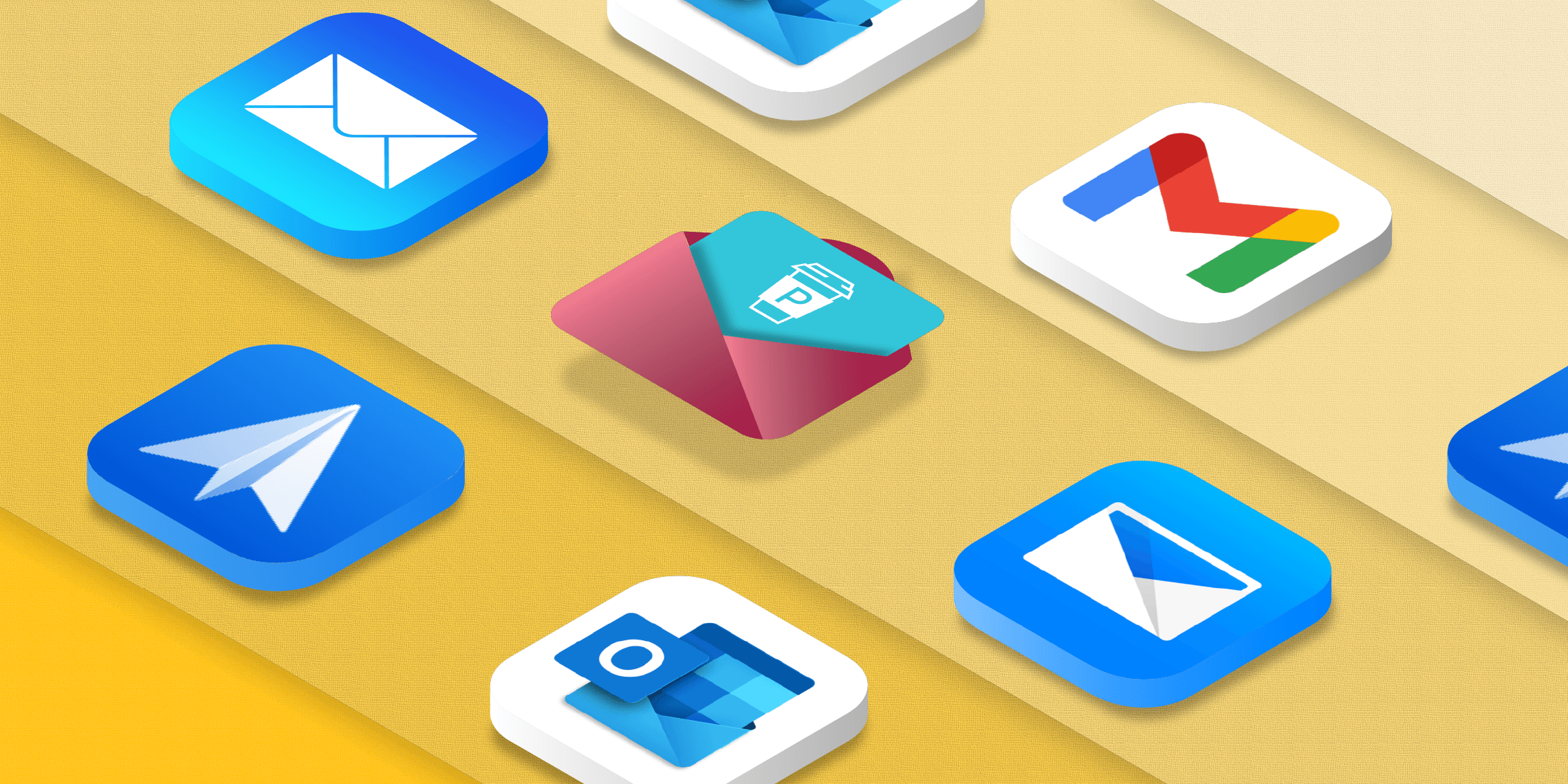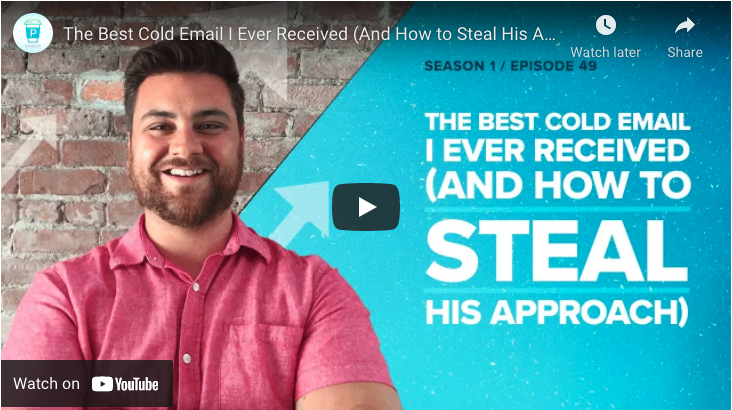(This article was originally published on 8/01/2017 and updated on 6/01/2021)
If you're like me, you probably get at least one or two cold emails every day. At least. They either slither past your spam filter into your inbox or worse -- you receive a message from a random person or recruiter on LinkedIn. The kind that you scan for less than a second before pressing delete. After years of receiving (and ignoring) an endless stream of unwanted emails and messages, I started to wonder if all of that outreach was really worth the effort.
Do Cold Emails Even Work?
According to some tests by a company called Yesware, their cold emails received a 30-50% response rate. On the other end of the spectrum, Casey Stanton from DigitalMarketer sent almost 12,000 test emails and received 125 replies, which is a 1% response rate.
Suffice to say, results may vary. This got me wondering what makes for the best cold email - one that captures a prospect's attention and evokes a response, and what goes into a terrible email - one that gets stuck in your spam folder or left unread every day.
What makes a bad cold email?
I went through my LinkedIn emails to find one of the worst cold email examples of what not to do, and came across this gem:
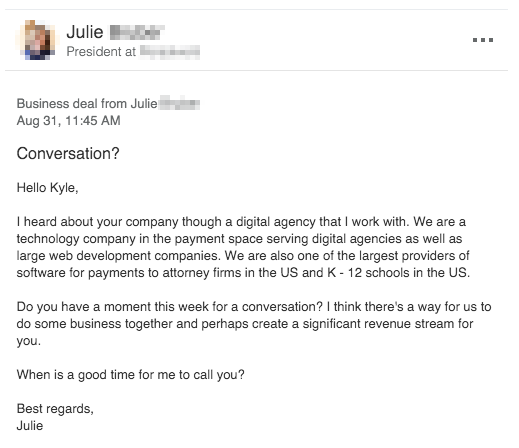
Poor Julie makes a number of cold email blunders here:
1. Too vague and self-indulgent
- "I heard about your company through a digital agency" ... Who? If we have a common interest, it will add more credibility to the email.
- "Technology company in the payment space." This could be pretty much any company.
- "One of the largest providers of software for payments to attorney firms in the US and K-12 schools." This isn't relevant to me or my business.
- "Create a significant revenue stream for you" Talk is cheap. Everyone says they'll create revenue for you or grow your business; without a specific value proposition, "growth" and "revenue" mean nothing in a cold email.
2. Assumes too much
Using the subject line "Business deal from Julie ___" implies that I'm already interested in doing business with Julie and we're at the deal stage. This is like walking up to someone you just met and talking marriage with them. Let's get to know each other first, OK?
3. Pushes for a call before telling me why
The primary goal of cold outreach is to develop a connection with a potential client. Julie didn't capture my attention or interest, so she failed right from the start. She told me all about her company without even identifying a pain point or giving me a reason to care. And then she has the gall to ask when it's a good time to have a call?
I may sound cranky, but this is the inner dialogue that goes on almost subconsciously in my mind when I'm reading an email like this. And I'm sure I'm not alone. If you want me to respond to your cold pitch, you'll need to make it memorable. Without an appealing subject line, relevant social proof, or actionable information, these types of sales emails get sent straight to spam.
The best example of a cold email
Now that we've established what not to do, I'd like to present the best cold email I’ve ever received.
Subject line: Magic Goggles
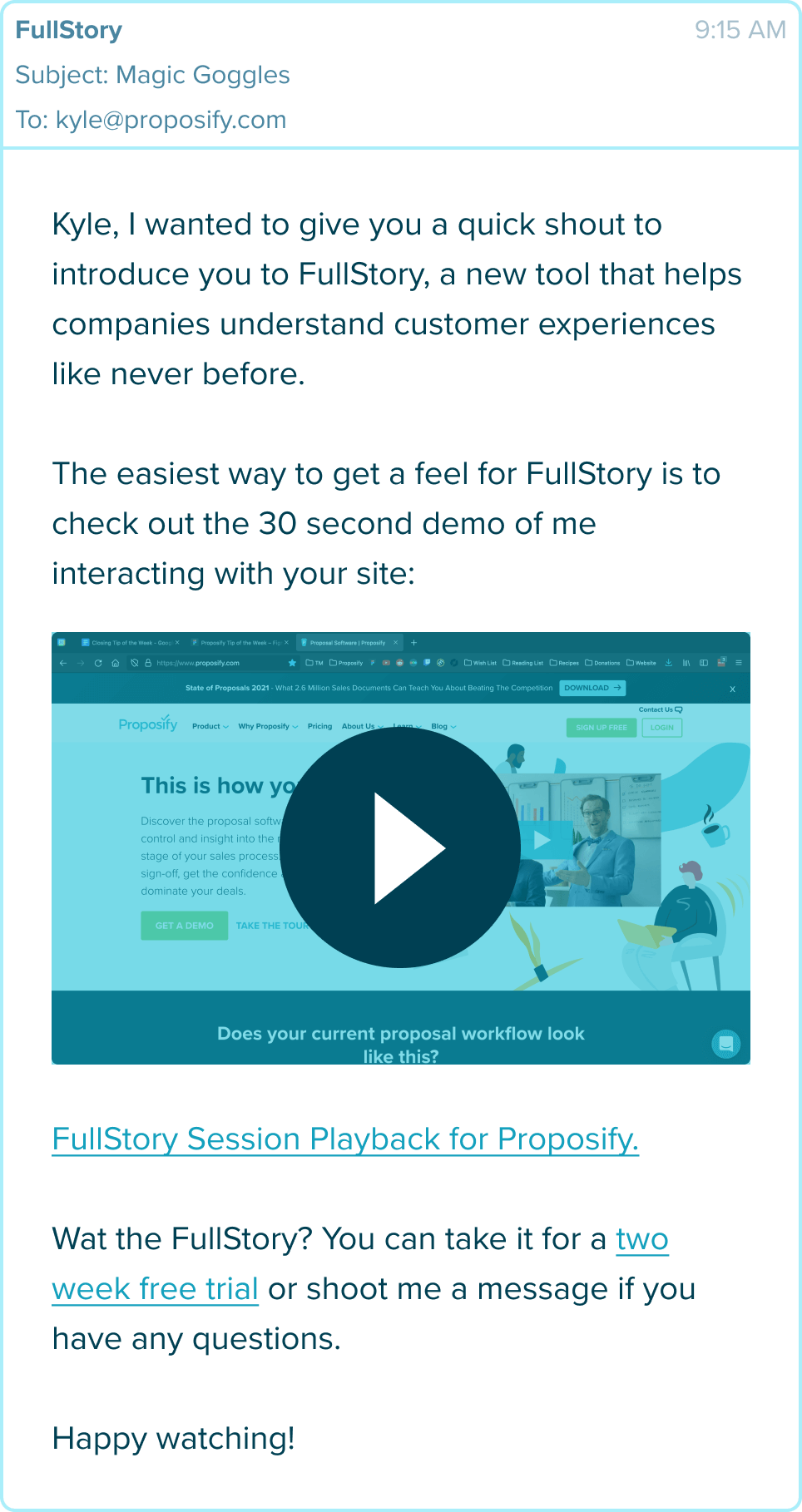
This email dates back to a previous version of our site, but it continues to stand the test of time
As soon as this email came into my inbox, the first thing I noticed was an animated image of our website, the Proposify home page. That was like holding a bag of gummy worms over a toddler's head and saying, "Want this?"
Next, notice what Trey writes in the body of his message:
"Kyle, I wanted to give you a quick shout to introduce you to FullStory, a new tool that helps companies understand customer experiences like never before."
In just a few more characters than a Tweet, Trey shows that he knows what I care about by identifying a pain point. Proposify is a SaaS company. We care about delivering great experiences to our customers, and understanding those experiences is top-of-mind for us.
He didn't promise "growth" or "revenue", he promised something much more tangible. Understanding my customer experiences like never before. OK, I'm interested.
"The easiest way to get a feel for FullStory is to check out the 30-second demo of me interacting with your site:"
This next line shows that Trey has taken the time to research Proposify and show how the tool can be used on our own website. It's all about ME, not him. And it will take 30 seconds of my time.
"Want the FullStory? You can take it for a two-week free trial or shoot me a message if you have any questions. Happy Watching!"
This call to action is fantastic because it demands very little of me. If I'm interested, try it out for free. If I have questions, ask. This tells my croc brain that Trey is confident in his product and isn't trying to pressure to buy me over the phone.
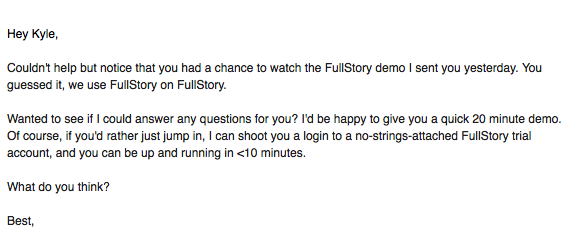
This was a great follow-up email and resulted in us having a back-and-forth email conversation, which is what you want from a cold email.
The goal of a cold email is to learn if a prospect is right for you, not close a deal.
Trey caught me clicking his link, so he knew I was at least somewhat interested in what FullStory could do. That warranted a follow-up email.
How to write an effective cold email
You may be thinking, "Sure, this approach might work if you're selling a SaaS product, but do cold emails work when selling marketing or design services (or pool installation, or whatever service you offer)?"
Short answer: I don't know, I haven't tried it. But according to one of our podcast guests, Alex Berman of Experiment 27, who closed $400K of business in 30 days using cold outreach, you sure can.
Here's how to write successful cold emails of your own:
1. Pick a narrow target
What made Trey's cold email stand out was that I felt like he knew me. This wasn't a shotgun blast out to a purchased list. He found my website, knew Proposify was his ideal customer, and went after the CEO (me).
It's essential that you know your perfect, ideal customer; their position in the company (CEO, marketing director, finance, IT, whatever), the number of employees, their annual revenue, and their industry. Then build up a lead list of people in your target audience to research and go after.
2. Find leads
LinkedIn Sales Navigator is a great place to find your ideal client and which person at that company you should be emailing.
You can also use a tool likeContacts+ to get more information on a prospect right within Gmail. It allows you to test different email formats to find someone's email, and if their email is connected to any social media, it will show up when you get it right.
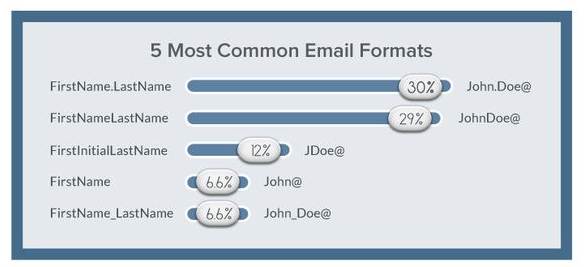
A tool like Hubspot CRM pulls in details from across the web on who your contact is, their company size, industry, annual revenue, and so on.
Using this information, you should be able to pull together a narrow list of companies that could be a good fit.
3. Create a lead magnet
We normally think of lead magnets as being an ebook, blog post, or cheat sheet that is given away on a landing page to get someone's email address. But you can use personalized lead magnets, like Trey's 30-second Proposify video, to make potential leads an offer they can't refuse (or refuse to click on, at least).
You can use a tool like Similarweb to get a full report on any website; simply go to the website and enter a URL.
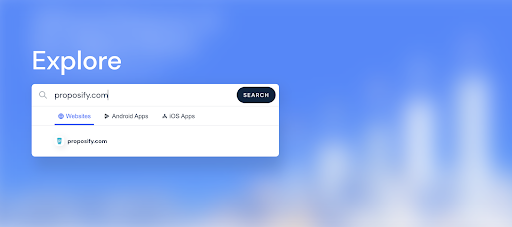
After a few seconds, it crawls the website and pulls together a full report on SEO, traffic, audience insights, backlinks, social sharing, and a ton of other information.
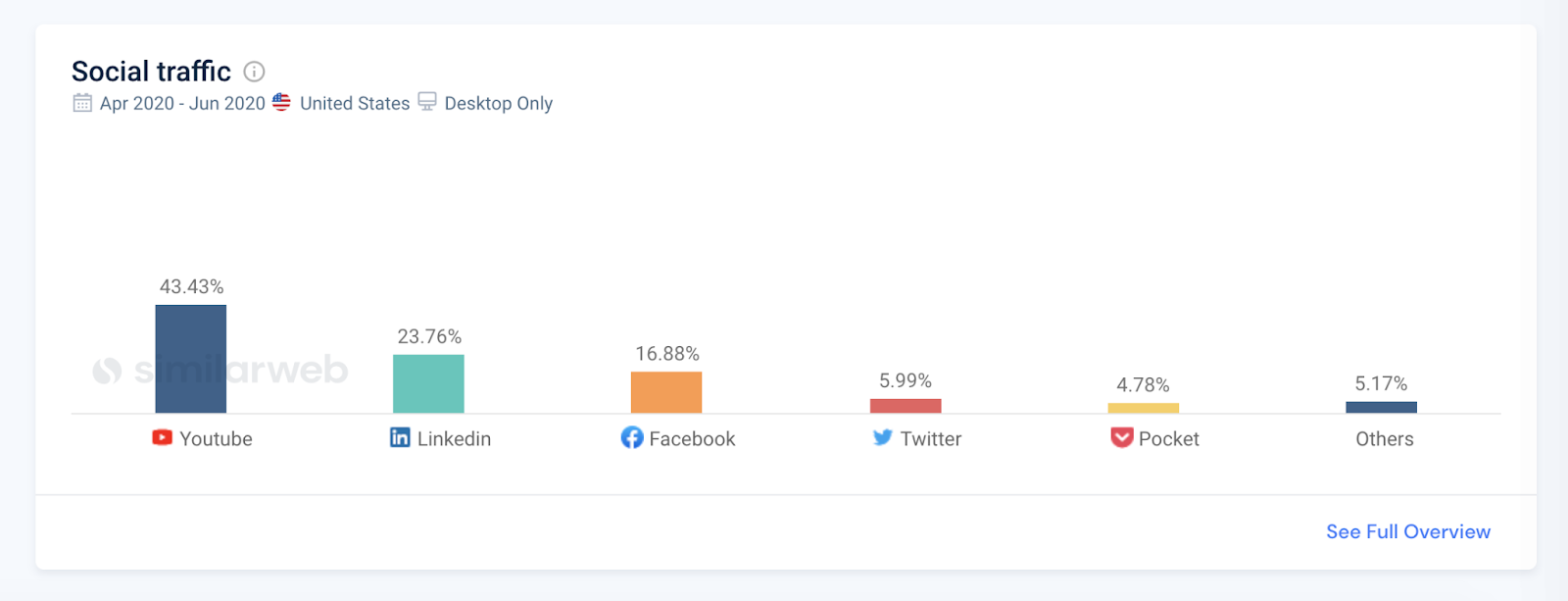
Take whatever data is relevant, and put it together into a beautiful, branded report with the client's logo or home page on the cover. You're going to use this image in your cold email, so the first thing the client sees is their own brand, showing that this is about them and you took the time to learn about them. Don’t include the full report in your email, just include a screenshot and link the image to a place where they can download it so you can track their opens and clicks.
For example, using Proposify, you could design an awesome looking presentation or report that you can quickly swap out customized information depending on the client you’re pitching.
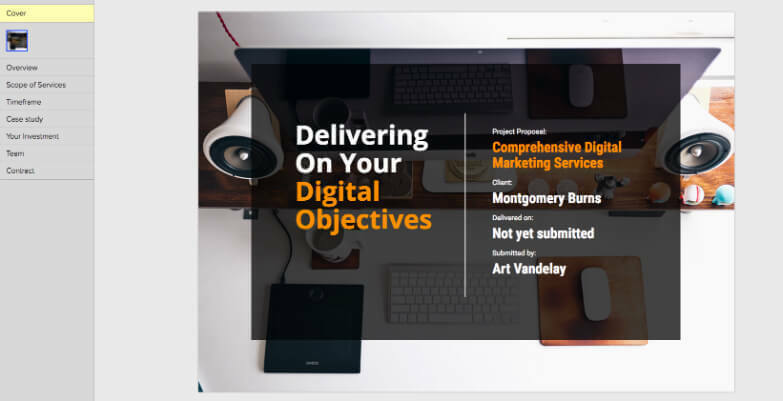
You can turn off the fee table and accept/decline buttons, so the only thing your client can do is open and download the PDF of your presentation.
You’ll get notified as soon as your client opens the email, clicks the link to view the proposal, and you’ll see an activity feed showing which sections they looked at in the document.
4. Keep your cold email short and simple
Remember Trey's email; he didn't use a lot of words. He made it about me and the one thing he wanted me to do: Click the link to view the lead magnet.
Check out the difference between the length of Julie's cold email compared to Trey's. Julie's email was 102 words and told me nothing about why I should care. Trey's email was 30 words and got me curious and excited to learn more.
5. Be light-hearted or humorous
According to Yesware, emails with humour received a 46% open rate. Humour is a great way to connect with your prospect and increase the chances of getting a response, but it needs to be done right; here are the three Ws of using humour in your business communication.
Trey’s email wasn’t funny, but he kept the language clear and friendly, ending it with “Happy Watching!” Test your approach, and you’ll learn what works over time.
6. Track opens/clicks and have your follow-up email ready
Use a tool like Proposify to track opens and clicks, and you’ll gain full transparency into each stage of the sales process. You'll get notified as soon as your client opens the email, clicks the link to view the proposal, and you'll see an activity feed showing which sections they looked at in the document.
Since you're using a tool that lets you know when a prospect has clicked your link and opened your lead magnet, you'll be able to follow up with a canned response like the one Trey sent.
Here’s another follow up email example:
Hey Betsy,
Couldn't help but notice that you had a chance to open the social media report I ran on [client_company] yesterday. There were some interesting trends and a bit of room for improvement.
Wanted to see if I could answer any questions for you? I'd be happy to give you a quick 20-minute demo on [our_company] to show how we can help.
If you're busy, no problem, just check out this 20-minute webinar we recorded that shows how we helped another clothing/apparel company like yours improve their conversion rate by 26% in 3 months. What do you think?
Best,
Kyle
Conclusion
Cold emails don't need to make you feel like a cold fish. Cold outreach can lead to lucrative opportunities, provided you can reach the right person and capture your prospect's attention.
Having trouble getting started? Join Proposify for free and you’ll get access to email templates and other tools that can help you send, track, and close your deals.
